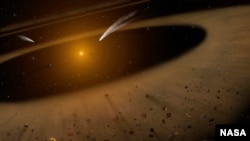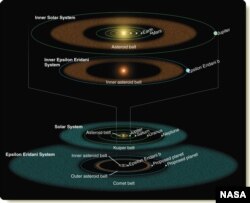A relatively nearby planetary system is structured remarkably like what ours probably looked like when it was young, the U.S. space agency NASA confirms.
The system around the star Epsilon Eridani, or eps Eri, is just 10.5 light-years away and astronomers say it provides an excellent example of how planets form around stars in systems like ours.
Previous studies of the system using the Spitzer Space Telescope led to two theories about how the system formed. One suggested a wide debris disk made up of gas, dust and small rocky and icy bodies. Another suggested several thin debris disks similar to our system, which has an asteroid belt between Mars and Jupiter, and the Kuiper Belt of mostly icy objects beyond the dwarf planet Pluto.
Using the Stratospheric Observatory for Infrared Astronomy, or SOFIA, astronomers found eps Eri has two narrow bands like our system. Furthermore, they detected a Jupiter-sized planet roughly the same distance from its star as Jupiter is from the sun.
“It really is impressive how eps Eri, a much younger version of our solar system, is put together like ours,” said Kate Su of the University of Arizona who led the study.
SOFIA, which is a larger telescope than Spitzer, is mounted on a Boeing 747. It previously found oxygen in Mars’ atmosphere, offered close-up looks at Jupiter and has documented the formation of new stars.
If the name eps Eri sounds familiar, you may have already heard of it as the setting for the science fiction television series Babylon 5.
The description of eps Eri was published in the Astronomical Journal on April 25, 2017.









